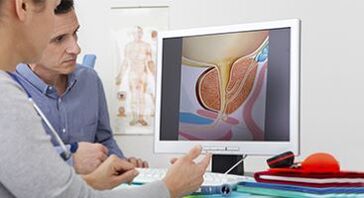Prostatitis and prostate adenoma are common diseases in men. It is not surprising that the strong are interested in their symptoms and other characteristics. Let us figure out how these pathologies are different and how to treat them.

Prostatitis and prostate adenoma are common diseases in men.
What is the difference between prostate adenoma and prostatitis?
In fact, there are enough differences.
They are related to the following factors:
- Time of onset.Prostatic adenoma is usually diagnosed in men between 45 and 50 years old, and prostatitis also afflicts older and younger members.
- The first symptom.Usually, patients with prostatitis will complain of discomfort (including very obvious pain), while patients with adenoma will complain of urinary system disease.
- the reason.Prostatitis is an inflammatory process that can be caused by infection of the reproductive tract, while prostatic adenoma is the overgrowth of tissue due to various factors.
- Clinical picture.Acute prostatitis is often accompanied by chills and fever, and the adenoma progresses without signs of infection.
- The nature of pain.The inflammation is characterized by acute pain in the groin, perineum, and rectum. Early tumors may not appear in any way. Even if it hurts, it doesn't matter.
For both pathologies, sexual dysfunction is characteristic.
Causes of the development of prostatitis

The disease mainly develops under the influence of microorganisms that enter the prostate from various sources. Usually, prostatitis occurs in the context of sexually transmitted infections.
The disease mainly develops under the influence of microorganisms that enter the prostate from various sources.
Some experts divide stagnant prostatitis into a separate group. This disease is caused by the destruction of blood circulation in the small pelvis. In this context, inflammation occurs. The infection is added fast enough. As a result, congestive prostatitis becomes chronic.
Symptoms of the disease
Prostatitis can occur in two forms: acute and chronic.

Not in all cases, acute prostatitis will have obvious symptoms. Some men only report general malaise, mild pain, and temporary diminished sexual function.
The following symptoms are characteristic of the acute form:
- Perineal pain;
- Pain under the scrotum;
- Increased body temperature;
- Pain during defecation;
- Increased urination;
- Frequent urination; painful urination;
- Erectile dysfunction.
In addition, the patient complained of purulent and mucous discharge in the urethra, pain in the perineum and groin, excessive excitement, and painful ejaculation.
important! Not in all cases, acute prostatitis will have obvious symptoms. Some men only report general malaise, mild pain, and temporary diminished sexual function. These symptoms are a slow form of prostatitis, similar to prostate adenomas, and may lead to incorrect diagnosis.
Chronic pathology is characterized by 3 main signs:
- pain.Men complain of sore rectum and waist, back pain, tingling sensation and "goose bumps" in the groin, thighs, perineum and back. In this context, the patient may become nervous. In addition, men will notice sweating and chills.
- Urinary dysfunction.Men complain of slow urine flow, difficulty emptying the bladder, and often want to go to the toilet.
- Sexual dysfunction.The patient noticed decreased libido, insufficient or premature ejaculation, and difficulty in getting a full erection. Infertility usually occurs in the context of prostatitis.

The pelvic nerves are often involved in pathological processes. As a result, additional symptoms are added to the main symptoms of prostatitis. They include hot flashes and increased body temperature at night, tachycardia, and mood swings and inattention. Some men complain of fatigue and sleepiness during the day, suspiciousness, a lump in the throat, increased saliva production, and weight gain (there is no change in diet and physical activity).
The reason for the benign proliferation of glandular tissues is the changes in the metabolism of testosterone in the cells.
Causes of prostate adenoma
The reason for the benign proliferation of glandular tissues is the changes in the metabolism of testosterone in the cells. This process is unavoidable and starts with a man who is about 40-45 years old. Therefore, every representative of a strong gender will encounter pathological signs more or less. Usually, benign tumors have no obvious symptoms in the first stage, but have been diagnosed by the time they are 2 or 3 years old.
Symptoms of glandular tissue hyperplasia
The difference between prostatitis and prostate adenoma lies in the main symptoms. For benign tumors, dysuria is always prominent.

The difference between prostatitis and prostate adenoma lies in the main symptoms. For benign tumors, dysuria is always prominent.
They are usually divided into two groups:
- Signs of irritation.The patient complained of increased urge to urinate, the need to empty the bladder regularly at night, and urinary incontinence.
- Obstructive signs.They are the result of the narrowing of the urethra as the glands grow. They show that they need to exert force when urinating, the urine flow is weak and dripping.
As the disease progresses, the kidneys, ureters, and pelvis are all involved in the pathological process. This can lead to increased blood pressure, back pain, constant thirst, itching, weakness, and deterioration of overall health. The patient has disease of the cardiovascular system. In addition, men complain of suppressed sexual function. Infectious complications of prostate adenoma were also detected. In some cases, stones form in the bladder. Signs of varicose veins (if any) may also worsen.
Principles of treatment of prostatitis and prostate adenoma
Use various drug groups for disease treatment.
The treatment of prostatitis aims to:
- Inhibit the inflammatory process;
- Prevent the active reproduction of bacteria;
- Improve the lymphatic outflow and blood circulation of the small pelvic veins;
- Prevent the chronicity of the pathological process.
For these purposes, patients are prescribed anti-inflammatory and antibacterial drugs, as well as intravenous injections and blood thinners. Enzyme preparations and immune response stimulants are recommended.
The treatment of prostate adenoma is aimed at:
- Volume reduction
- Return to normal urination.
In order to solve these problems, patients were prescribed α-receptor blockers, 5-α-reductase inhibitors, plant preparations and other drugs.

Both prostatitis and prostate adenoma may need to be restored. For this reason, combination preparations are formulated based on herbal ingredients and other ingredients. The funds can be used simultaneously with the treatment of major diseases. If taken correctly, they are harmless to the body.
important! Any medicine is specially prescribed by a doctor. Self-administration is strictly prohibited. It can change the clinical manifestations and make diagnosis difficult. In addition, self-prescribing medication can lead to deterioration of health. You should not cancel the drug yourself!
In some cases, surgical treatment is performed for diseases. This kind of prescription is prescribed when conservative treatment is ineffective or inappropriate for some reason or other reasons.
Usually, surgical intervention is related to the 2-3 stages of prostate adenoma.
The main operations include:
- TUR (transurethral resection);
- Laser Treatment;
- Laparoscopy;
- Use Da Vinci robots to intervene.
All operations are minimally invasive. They reduce damage to healthy tissues and provide a shorter recovery period.

The surgical technique is selected by the doctor according to the available indications, the patient's concomitant diseases and their individual characteristics.
Successful treatments for prostate adenoma and prostatitis include:
- Quit bad habits (smoking and alcohol);
- Exclude animal fats, as well as canned foods, smoked and fried foods;
- Restrict simple carbohydrate diet;
- Ingest enough body fluids (at least 2 liters of water);
- See a doctor regularly. You should contact him even if there are no signs of pathology. This will allow timely identification of all changes and prevent the development of complications.
Benefits of going to the clinic
- Experienced doctor.Our experts have been involved in the diagnosis and treatment of prostate diseases for a long time. They have the knowledge and skills required to perform various operations.
- Possibility of rapid diagnosis.Our experts use expert-grade equipment. It allows you to make a diagnosis on the day of treatment.
- An individualized treatment method.Taking into account the type and stage of the disease, the characteristics of the patient and his comorbidities, the treatment of prostatitis and prostate adenoma is provided.
- Conservative therapy using modern technology.
- Modern surgical treatment methods.Use lasers and Da Vinci robots for surgical intervention. Perform laparoscopic surgery and TUR (transurethral resection). This allows you to reduce the risk of intervention and the duration of the recovery period.
- The comfort of visiting the clinic.They are located near the subway. In addition, we have solved the problem of not having to queue up and are ready to receive patients at their convenient time.
























